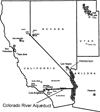Perchlorate clinical pharmacology and human health: a review
- PMID: 11477312
- PMCID: PMC3640367
- DOI: 10.1097/00007691-200108000-00002
Perchlorate clinical pharmacology and human health: a review
Abstract
Potassium perchlorate has been used at various times during the last 50 years to treat hyperthyroidism. Since World War II ammonium perchlorate has been used as a propellant for rockets. In 1997, the assay sensitivity for perchlorate in water was improved from 0.4 mg/L (ppm) to 4 microg/L (ppb). As a result, public water supplies in Southern California were found to contain perchlorate ions in the range of 5 to 8 ppb, and those in Southern Nevada were found to contain 5 to 24 ppb. Research programs have been developed to assess the safety or risk from these exposures and to assist state and regulatory agencies in setting a reasonable safe level for perchlorate in drinking water. This report reviews the evidence on the human health effects of perchlorate exposure. Perchlorate is a competitive inhibitor of iodine uptake. All of its pharmacologic effects at current therapeutic levels or lower are associated with inhibition of the sodium-iodide symporter (NIS) on the thyroid follicular cell membrane. A review of the medical and occupational studies has been undertaken to identify perchlorate exposure levels at which thyroid hormone levels may be reduced or thyrotropin levels increased. This exposure level may begin in the 35 to 100 mg/d range. Volunteer studies have been designed to determine the exposure levels at which perchlorate begins to affect iodine uptake in humans. Such effects may begin at levels of approximately 1 mg/d. Environmental studies have assessed the thyroidal health of newborns and adults at current environmental exposures to perchlorate and have concluded that the present levels appear to be safe. Whereas additional studies are underway both in laboratory animals and in the field, it appears that a safe level can be established for perchlorate in water and that regulatory agencies and others are now trying to determine that level.
Figures
Similar articles
-
Perchlorate and thyroid function: what are the environmental issues?Thyroid. 2005 May;15(5):427-31. doi: 10.1089/thy.2005.15.427. Thyroid. 2005. PMID: 15929663 Review.
-
Health effects assessment for environmental perchlorate contamination: the dose response for inhibition of thyroidal radioiodine uptake in humans.Environ Health Perspect. 2002 Sep;110(9):927-37. doi: 10.1289/ehp.02110927. Environ Health Perspect. 2002. PMID: 12204829 Free PMC article.
-
Clinical studies of exposure to perchlorate in the United States.Thyroid. 2007 Sep;17(9):819-22. doi: 10.1089/thy.2007.0105. Thyroid. 2007. PMID: 17705696 Review.
-
Interference on Iodine Uptake and Human Thyroid Function by Perchlorate-Contaminated Water and Food.Nutrients. 2020 Jun 4;12(6):1669. doi: 10.3390/nu12061669. Nutrients. 2020. PMID: 32512711 Free PMC article.
-
Perchlorate versus other environmental sodium/iodide symporter inhibitors: potential thyroid-related health effects.Eur J Endocrinol. 2006 Jul;155(1):17-25. doi: 10.1530/eje.1.02190. Eur J Endocrinol. 2006. PMID: 16793945 Review.
Cited by
-
Environmental exposure to perchlorate, nitrate, and thiocyanate in relation to chronic kidney disease in the general US population, NHANES 2005-2016.Chin Med J (Engl). 2023 Jul 5;136(13):1573-1582. doi: 10.1097/CM9.0000000000002586. Chin Med J (Engl). 2023. PMID: 37154820 Free PMC article.
-
Comparison of toxicity values across zebrafish early life stages and mammalian studies: Implications for chemical testing.Reprod Toxicol. 2015 Aug 1;55:3-10. doi: 10.1016/j.reprotox.2014.09.005. Epub 2014 Sep 28. Reprod Toxicol. 2015. PMID: 25261610 Free PMC article.
-
Genetic factors that might lead to different responses in individuals exposed to perchlorate.Environ Health Perspect. 2005 Nov;113(11):1479-84. doi: 10.1289/ehp.8076. Environ Health Perspect. 2005. PMID: 16263499 Free PMC article. Review.
-
Possible Effects of Perchlorate Contamination of Drinking Water on Thyroid Health.J Thyroid Res. 2020 May 13;2020:5208657. doi: 10.1155/2020/5208657. eCollection 2020. J Thyroid Res. 2020. PMID: 32454966 Free PMC article.
-
Newborn thyroxine levels and childhood ADHD.Clin Biochem. 2002 Mar;35(2):131-6. doi: 10.1016/s0009-9120(02)00284-9. Clin Biochem. 2002. PMID: 11983348 Free PMC article.
References
-
- Okamoto HS, Rishi DK, Steeper WR, et al. Using ion chromatography to detect perchlorate. J Am Water Works Assoc. 1999;91:73–84.
-
- US Environmental Protection Agency. Perchlorate Environmental Contamination: Toxicological Review and Risk Characterization Based on Emerging Information. Washington, DC: US Environmental Protection Agency; 1998. Publication NCEA-1-0503: 5–32—5–38.
-
- Southern Nevada Water Authority. Feb 22;
-
- Stanbury JB, Wyngaarden JB. Effect of perchlorate on the human thyroid gland. Metab Clin Exp. 1952;1:533–539. - PubMed
-
- Carrasco N. Iodide transport in the thyroid gland. Biochim Biophys Acta. 1993;1154:65–82. - PubMed
Publication types
MeSH terms
Substances
Grants and funding
LinkOut - more resources
Full Text Sources
Research Materials



